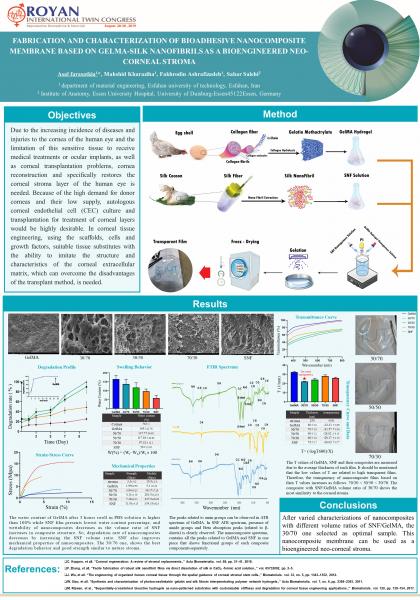- English
- فارسی
2017-FarasatKia.A.
 |
 |
Asal Farasatkia
Email: asalfarasatkia73@gmail.com
- MSc, (2017-2020): Fabrication and characterization of bioadhesive nanocomposite membrane based on silk nanofibrils-GelMA as a bioengineered neo-corneal stroma
Abstract:
Increasing abnormalities in the human cornea and the limitation of this sensitive tissue for receiving therapeutic treatments or eye implants, as well as lack of resources and problems with corneal transplantation, necessitate corneal remodeling and specifically remodeling of the human eye stroma layer. The stroma differs from other collagen-based tissues because of its transparency due to the precise structure of the collagen fibers and the extracellular matrix. Although there have been numerous studies of corneal tissue engineering so far, none have succeeded in constructing a scaffold for reconstructing the corneal stromal layer separately, with drug loading capability to accelerate the regeneration process and prevent inflammation and infection during differentiation of corneal stroma cells (HS-5s). The scaffold should be able to attach to the corneal tissue to prevent stitching problems in the eye. In addition, providing transparency, robustness and orientation of the engineered tissue structure is one of the requirements of this activity. The purpose of the present study was to introduce corneal tissue engineering, easy and feasible manufacturing methods and polymeric materials needed for the preparation of suitable scaffolds for the reconstruction of the corneal stroma layer. In this study, micromolding technique was used in order to provide a suitable method for designing and optimizing silk nanofibril(SNF)-gelatin methacrylate (GelMA) layered nanocomposite membrane. The alginate is also expected to be considered as an adhesive substrate because of its excellent adhesion properties so that the SNF/GelMA nanocomposite membrane can adhere well to the endothelial tissue without suturing and allow the growth and remodeling of the stromal layer. This adherent membrane can also be used as a carrier for ascorbic acid to transform into a matrix supporting keratocyte cells, stimulating cell growth, antioxidant activity and improving the final function of the scaffold. It is hoped that this nanocomposite dual-layer membrane could be a suitable replacement for the damaged natural stroma and provide the native conditions of this particular tissue and lead to the restoration of the stroma layer.
Outcome:


